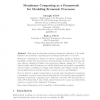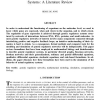954 search results - page 64 / 191 » Principles and Models for Organizing the IT Function |
CMOT
1999
13 years 7 months ago
1999
We propose a class of actor-oriented statistical models for closed social networks in general, and friendship networks in particular. The models are random utility models develope...
SYNASC
2005
IEEE
14 years 1 months ago
2005
IEEE
Abstract. This paper is a first step towards a systematic evaluation of the possibilities to use membrane computing as a modeling framework for economics. Membrane computing is a ...
BIOSYSTEMS
2008
13 years 7 months ago
2008
This paper aims to offer an overview of the meaning of autonomy for biological individuals and artificial models rooted in a specific perspective that pays attention to the histor...
UIST
2000
ACM
14 years 2 days ago
2000
ACM
Traditionally, designers organize software system as active end-points (e.g. applications) linked by passive infrastructures (e.g. networks). Increasingly, however, networks and i...
JCB
2002
13 years 7 months ago
2002
In order to understand the functioning of organisms on the molecular level, we need to know which genes are expressed, when and where in the organism, and to which extent. The reg...


